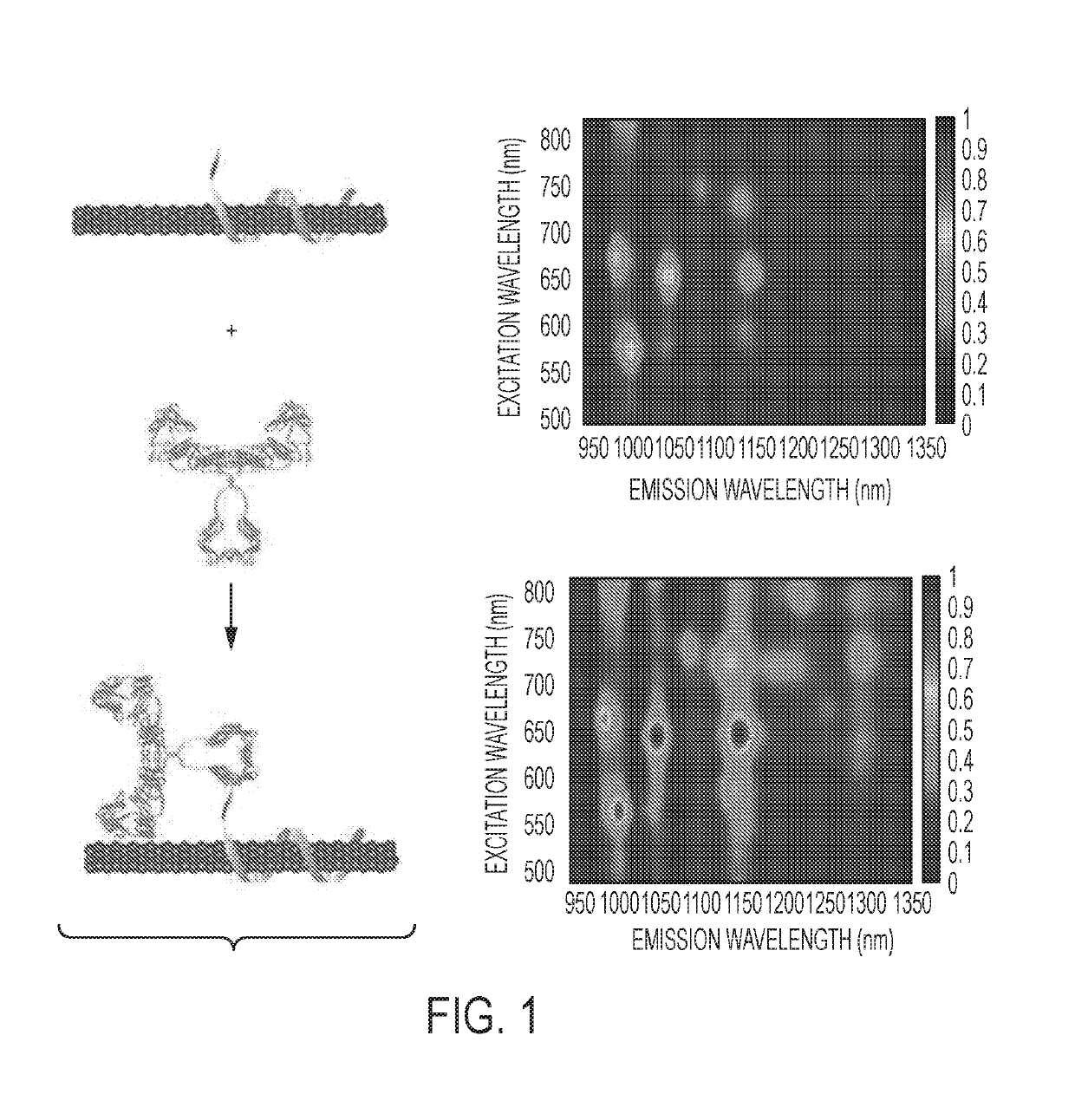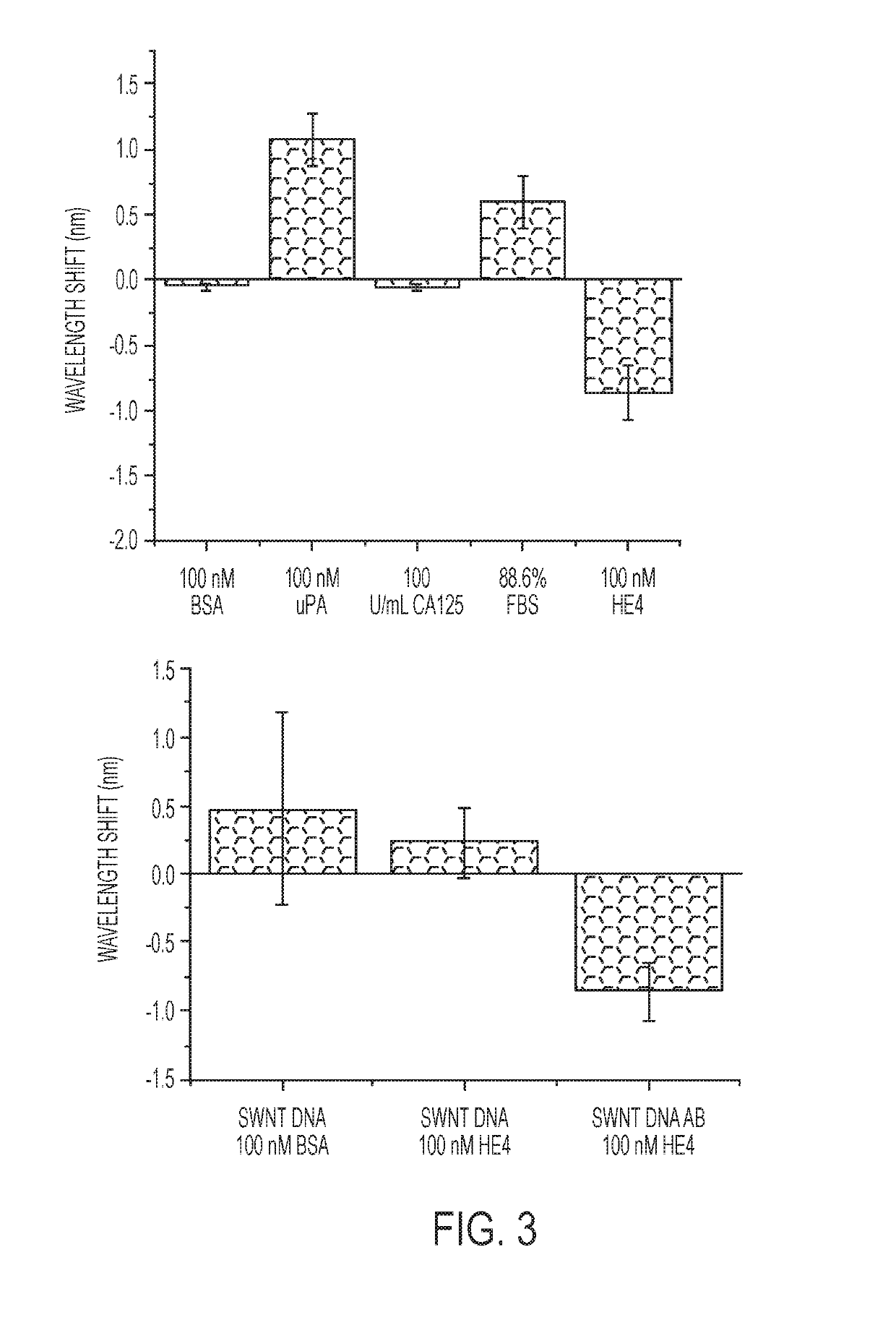Swcnt-dna-antibody conjugates, related compositions, and systems, methods and devices for their use
a technology of dna and conjugates, applied in the field of swcntdnaantibody conjugates, can solve the problems of poor detection sensitivity, lack of widespread clinical use of current detection techniques of protein biomarkers for diagnosis and monitoring of diseases, and methods that neither alter patient outcome nor reduce mortality, so as to improve the multiplexing capability of tissue analyte localization and quantification, and improve the detection accuracy and specificity. , the effect of increasing the multiplex
- Summary
- Abstract
- Description
- Claims
- Application Information
AI Technical Summary
Benefits of technology
Problems solved by technology
Method used
Image
Examples
experimental examples
Carbon Nanotube-Based Antibody Sensors Sensitive and Specific for Cancer Biomarkers
[0126]Experiments have been conducted with SWCNT biosensors for uPA (urokinase plasminogen activator) and HE4 (human epididymis protein 4), characterized in vitro. SWCNTs were suspended in solution with ssDNA oligonucleotides. Amine-modified DNA oligomers, of predetermined sequence and quantity, were commercially synthesized and purchased (IDT DNA). In the HiPCO SWCNT sample (Nanolntegris), there exists more than 12 chiralities of semi-conductive nature. This complex was functionalized with a commercially-available (Santa Cruz Biotechnologies) anti-uPA antibody or anti-HE4 antibody (RayBiotech) by EDC / NHS activation of the carboxylic acid groups on the antibody. These activated groups were conjugated to amine-functionalized DNA encapsulating SWCNT via a simple amidation reaction. Unconjugated antibody was dialyzed away to obtain purified antibody-DNA-SWCNT complexes (FIG. 1). Verification of conjugati...
example 1
Detection of HE4 Using Carbon Nanotube-Based Antibody Sensors
[0137]Early-stage detection of high-grade serous ovarian cancer (HGSC) remains elusive, potentially because FDA-approved serum biomarkers CA125 and HE4 do not appear at detectable levels until advanced stages of the disease.
[0138]Without wishing to be bound to any theory, an implantable device placed proximal to disease sites, such as the fallopian tube, ovary, uterine cavity, or peritoneal cavity, may constitute a feasible strategy to improve detection of HGSC. A prototype optical sensor composed of an antibody-functionalized carbon nanotube complex which responds quantitatively to HE4 via modulation of the nanotube optical bandgap was engineered. The complexes measured HE4 with nanomolar sensitivity to differentiate disease from healthy patient biofluids, and a semi-permeable sensor-loaded capillary, implanted surgically into four models of ovarian cancer, enabled the detection of HE4 optically within the live animals. I...
PUM
| Property | Measurement | Unit |
|---|---|---|
| wavelength | aaaaa | aaaaa |
| length | aaaaa | aaaaa |
| width | aaaaa | aaaaa |
Abstract
Description
Claims
Application Information
 Login to View More
Login to View More - Generate Ideas
- Intellectual Property
- Life Sciences
- Materials
- Tech Scout
- Unparalleled Data Quality
- Higher Quality Content
- 60% Fewer Hallucinations
Browse by: Latest US Patents, China's latest patents, Technical Efficacy Thesaurus, Application Domain, Technology Topic, Popular Technical Reports.
© 2025 PatSnap. All rights reserved.Legal|Privacy policy|Modern Slavery Act Transparency Statement|Sitemap|About US| Contact US: help@patsnap.com



